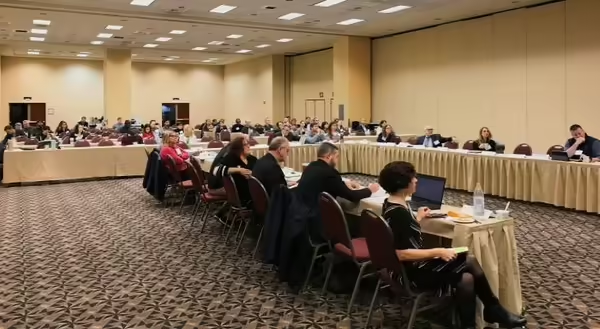
A Farm Bureau lawyer, a Sierra Club scientist, and a wastewater treatment plant operator walk into a conference room . . . It’s no joke. On December 3-4 in Springfield, these three and about 120 more people gathered to hear the latest on Illinois’ Nutrient Loss Reduction Strategy (NLRS). “We were happy to see such a great turnout. Since its adoption in 2015, we have focused on stakeholder partnerships to move the strategy forward. Together, we are greater than the sum of our parts,” says University of Illinois Extension and Illinois-Indiana Sea Grant Specialist and NLRS facilitator, C. Eliana Brown.
Illinois’ NLRS is a statewide strategy to reduce nutrients – mostly nitrogen and phosphorous – that flow into the Mississippi River from farm fields, wastewater treatment plants, and urban stormwater runoff. This nutrient-rich runoff depletes oxygen, causing hypoxia, or the “dead zone,” in the Gulf of Mexico that is unable to support fish and other aquatic life and damages the region’s economy. Illinois isn’t the only state contributing to the problem. All Mississippi River Basin states contribute, and most have strategies to mitigate nutrient loss. “Illinois participates in the Gulf Hypoxia Task Force, which includes twelve states,” says Brown. “Illinois serves as a model for engaging partners, including agricultural, urban and environmental stakeholders. With the third largest city in the nation, and 24 million acres of agricultural land, our state has significant nutrient sources. Therefore, we take the effort to reduce nutrient loss very seriously.”
Strategies to reduce nutrient runoff from Illinois, outlined in the 2015 NLRS plan, are monitored through annual data collections and documented every two years, most recently in November of 2019. Brown notes, “Water quality improvement can take a long time, and the trends aren’t always linear. While many factors affect water quality, some of which universities are just now starting to research, what we do know is that people from all sectors are doing much more now than when we started.”
The Partnership Approach
Warren Goetsch, who served as deputy director of the Illinois Department of Agriculture until he retired in December 2019, attributes the rise in participation to the Illinois strategy – using carrots, rather than sticks. “I believe that the state’s nutrient loss reduction strategy has provided a much needed focal point for both existing and new conservation programs for our many agriculture organizations. There is room in the strategy for every organization to contribute something to the nutrient loss reduction cause.”
Lauren Lurkins, who serves as Director of Environmental Policy at the Illinois Farm Bureau, concurs. “It is because of this framework that Illinois Farm Bureau has prioritized leading on environmental issues like the NLRS, and specifically, has committed over $1.5 million since 2015 to implement the NLRS.” Agricultural sector partners invested over $33 million to NLRS implementation in 2018, and reached 84,500 people through events and trainings. Over 70% of farmers planting corn are using at least one practice to keep nitrogen on the field and out of the water.
Concurrently, wastewater treatment plants have made significant capital investments that reduce nutrient loss. Annual statewide phosphorous loads from wastewater treatment plants were reduced by 4.3 million pounds between 2011 and 2018. That is a 24% reduction and puts the point source sector in line to reach its interim goal of a 25% reduction by 2025 – a major accomplishment.
“The NLRS gives all partners a voice in planning and implementation,” Brown says “Having a seat at the table encourages everyone to work together and think creatively about how to leverage both existing and future programs to meet state goals.”
Lurkins adds, “Frankly, Extension is the only entity who could and should facilitate the NLRS. Without their involvement, the legitimacy – to stakeholders, elected officials, regulators, and the scientific community – would lose credibility.”
Going forward
Even with all this work, overall nutrient runoff from the state has increased, according to a 2019 assessment of the water quality in Illinois’ rivers and streams conducted by University of Illinois professor emeritus, Dr. Gregory McIsaac. Some of the increase can be attributed to increased rainfall, but not all. “There is a lot of work to be done to reach the goals set out by the NLRS. By partnering with researchers, we hope to learn more about what is going on and what else we need to do,” says Brown.
This collaboration also comes with a price tag. To date, the Illinois Environmental Protection Agency (IEPA) has funded the NLRS. For the future, IEPA is seeking a more sustainable model that engages more of the stakeholders who see value in reducing nutrient loss. Partners are discussing how to ensure the progress can continue.
To learn more, find the NLRS and the 2019 biennial report here. You can also follow the strategy efforts on Facebook and Twitter at @IllinoisNLRS.